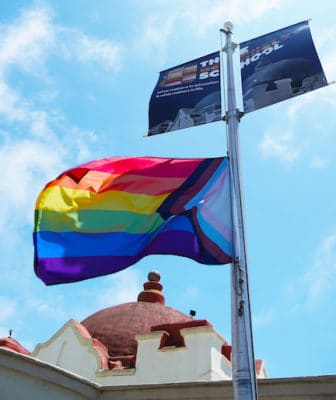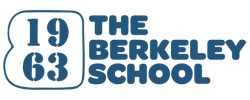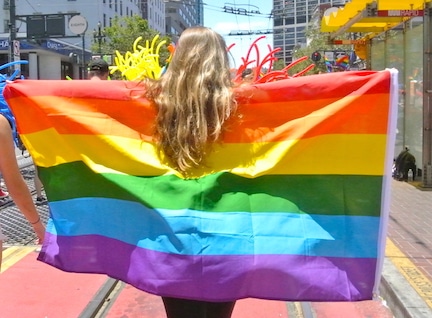By Kate Klaire, Director of Civic Engagement and GSA Facilitation Supporter
with contributions from Jackie Sa, 3rd Grade Teacher and GSA Jr. Facilitator
The Gender Sexuality Alliance (GSA) at The Berkeley School is a student-run group open to all LGBTQ+ and allied students who want a space to celebrate, educate, and advocate on behalf of their community and discuss issues that impact members of the LBGTQ+ community.
We know that children begin developing ideas about gender at a very young age. By preschool, kids recognize physical and social gender differences and by age 4, most children have a stable sense of their gender identity. We also know that children internalize stereotypes at a very young age, so the sooner we, as educators, can encourage them to recognize, challenge, and reject stereotypes, the better. When we allow our adult fears to limit children’s exposure to these topics, we discredit students’ agency and ability to be critical thinkers.
Research shows that offering student groups like a GSA and other identity-based affinity spaces at school helps the entire school community feel included — even for students who don’t participate.
Whereas GSA student groups are often found at the high school and middle school level, they are rarely offered to elementary students. At TBS, we understand and can show evidence of the value that a GSA group brings to an elementary school community. Members of our GSA range in age from 2nd grade to 8th grade. Since it’s important to keep kids in age-affinity groups, we offer separate meetings for 5th-8th graders and for 2nd-4th graders.
Research shows that offering student groups like a GSA and other identity-based affinity spaces at school helps the entire school community feel included — even for students who don’t participate. Just knowing that these spaces are provided and that every identity is embraced gives students of all ages the sense of safety and inclusiveness they need to be successful learners.
Student members of the GSA at The Berkeley School plan their own meetings and introduce discussion topics. Recently, students talked about gendered awards at awards shows like the Oscars, Grammys, Emmys, and Tonys. The kids discussed how forcing performers into female and male categories can be exclusionary to a lot of people and wondered why categories have to be gendered at all.
GSA members at TBS also choose to play a big advocacy role on our campus. Students regularly lead all-school assemblies about gender and sexuality and visit classrooms to offer presentations — tailored by age — in an effort to increase education and awareness.
7h grader Cole, who has been a GSA member for 3 years, points out, “There’s lots to teach people, no matter the age group. Some people may think middle schoolers know so much more about all this stuff, but sometimes second graders can know more than middle schoolers, so it’s important to give everyone the chance to educate.”
Here are just a few pieces of feedback from students at The Berkeley School about what the GSA has taught them.
 In 2018, GSA students educated our school community about the Progress Pride Flag, designed by Daniel Quasar. The Progress Pride Flag adds five arrow-shaped lines to the original Pride Flag, a six-colored rainbow flag designed by Gilbert Baker in 1978. Quasar’s flag includes black and brown stripes to represent marginalized LGBT communities of color, those living with AIDS, and those no longer living. The pink, light blue, and white colors are used on the Transgender Pride Flag. Students explained that the additional colors were added to be inclusive of the specific challenges of racism and transphobia faced by nonwhite and transgender members of the community.
In 2018, GSA students educated our school community about the Progress Pride Flag, designed by Daniel Quasar. The Progress Pride Flag adds five arrow-shaped lines to the original Pride Flag, a six-colored rainbow flag designed by Gilbert Baker in 1978. Quasar’s flag includes black and brown stripes to represent marginalized LGBT communities of color, those living with AIDS, and those no longer living. The pink, light blue, and white colors are used on the Transgender Pride Flag. Students explained that the additional colors were added to be inclusive of the specific challenges of racism and transphobia faced by nonwhite and transgender members of the community.
The Progress Pride Flag, which can be seen flying outside on our University Avenue Campus, celebrates those who were previously unsung in the LGBTQ+ Rights Movement.
It has been our honor to facilitate our GSA and GSA Jr. groups at The Berkeley School and we encourage other schools to offer their elementary students this opportunity to be a part of something that celebrates identity and promotes education. Give it a try with one meeting and see how it goes! Please feel free to reach out for further information.
Below is a resource list of books and videos for parents and educators.
GSA Books and Resources compiled by the CATDC (California Teachers Development Collaborative)
LGBTQ+ and Social Justice Videos for All Ages
- Queer Kid Stuff YouTube channel: Hosted by Lindsay Amer (they/them) – LGBTQ activist and content creator
- Lindsay’s TED talk about why kids need to learn about gender and sexuality
- NOTE: Kids should watch the videos with their grown ups’ supervision.
Resources about LGBTQ+ Rights History
- Marsha P Johnson and Silvia Rivera are getting a monument in NYC
- June 28, 1969: Stonewall Riots by Zinn Ed Project
- History of Pride March by NY Times
- Milestones in the American Gay Rights Movement
- Role of Gay Men and Lesbians in the Civil Rights Movement – Teaching Tolerance lessons
Articles Highlighting the Intersection of LGBTQ+ Rights History and Black Lives Matter
- “How a march for Black trans lives became a huge event” – NY Times
- “We must do better fighting for Black trans lives” – Essence
- “Black Trans Lives Matter: Movement Pushes for Justice & Visibility Amid “Epidemic” of Violence” – Democracy Now
Resources for LGBTQ+ Educators, curated by Tamisha Williams, Dean of Adult Equity & Inclusion at Lick-Wilmerding High School, and Laura Cartwright, National Training Director for One Circle Foundation
- Gender Spectrum Gender-Inclusive Puberty and Health Education
- 2018 LGBTQ Youth Report by Human Rights Campaign + PDF
- GSA network resources
- GenderSpectrum.org
- Center for Research & Education on Gender and Sexuality by SFSU
Affinity Group Resources
- Race-based Affinity Group Resource List from Tamisha Williams
- Bay Area Independent School Race-based Resources
- Resource List for Independent Schools Starting Affinity Groups from Rosetta Lee, Seattle Girls’ school
- Diversity, Equity, and Social Justice Workshops : Conferences : Resources for Educators and School Personnel (curated by Tamisha Williams)




